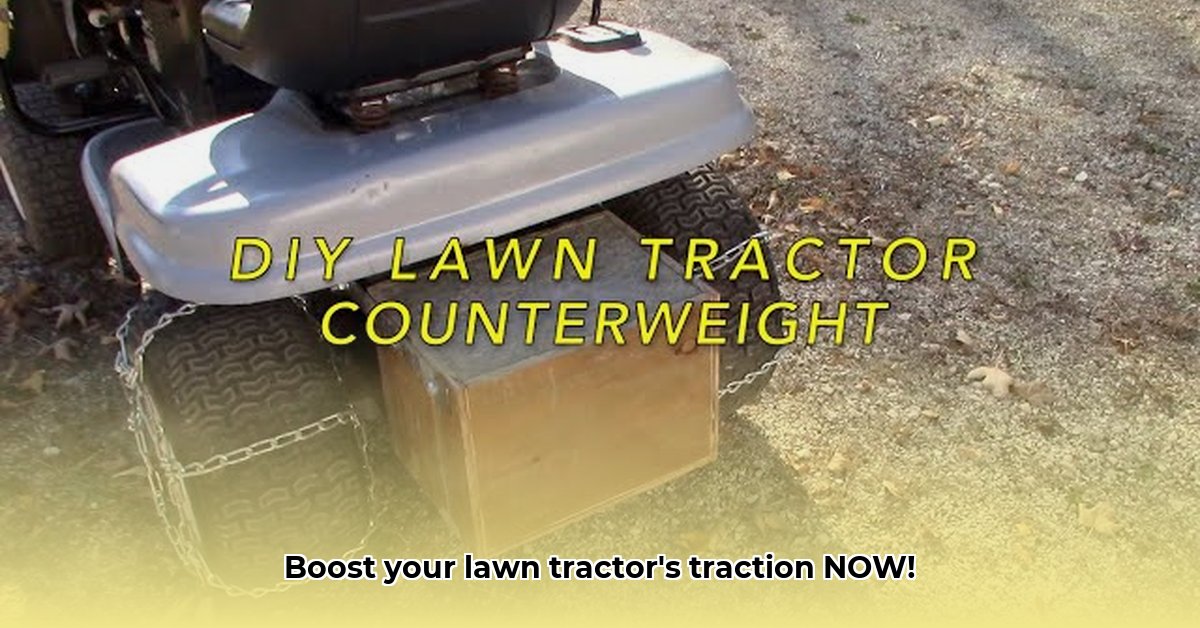
Tired of your lawn tractor spinning its wheels on hills or in wet grass? Adding weight can significantly improve traction, making tough jobs easier. This guide provides step-by-step instructions for creating DIY lawn tractor weights using two popular methods: cinder blocks and homemade lead weights. We'll also discuss safety precautions and help you choose the best approach for your needs. Is maximizing your lawn tractor's performance a priority for you? Let's dive in! For more detailed information on lawn tractor weights, check out this helpful resource: tractor weight options.
Cinder Blocks: The Budget-Friendly Choice
Cinder blocks offer a quick, inexpensive, and readily available solution for increasing your lawn tractor's weight. Their ease of use makes them an excellent option for beginners. However, keep in mind that they are less durable than other materials and might crack under stress. Do you prioritize affordability and ease of installation? Then cinder blocks are a great starting point.
Pros:
- Low Cost: Cinder blocks are inexpensive and widely available at most home improvement stores.
- Easy Installation: Requires minimal tools and experience.
Cons:
- Lower Durability: Susceptible to cracking or breaking under heavy loads.
- Limited Weight: May not provide the same level of weight increase as other materials.
How to Add Cinder Block Weights:
- Assess Your Tractor: Identify sturdy mounting points on your tractor's frame. Consult your owner's manual for guidance.
- Secure Mounting Hardware: Use heavy-duty brackets or have custom mounts fabricated by a professional welder to ensure secure attachment.
- Attach Cinder Blocks: Securely fasten the cinder blocks to the brackets using strong straps or chains. Overly tight straps can damage the blocks; aim for a secure but not overly aggressive fastening.
- Regular Inspection: Regularly inspect the blocks and hardware for damage. Replace damaged components immediately.
Lead Weights: Maximum Traction (With Crucial Safety Precautions)
Lead's high density makes it ideal for maximizing traction, especially on challenging terrain. However, lead is toxic and requires careful handling. This method demands more preparation and attention to safety protocols. Are you willing to prioritize superior traction and accept a more involved, safety-conscious process? Lead might be the right option.
Pros:
- Superior Density: Provides significantly better traction than cinder blocks.
- Customizable: Weights can be cast in various shapes and sizes.
Cons:
- Toxicity: Lead is a hazardous material. Appropriate safety measures are imperative.
- Specialized Equipment: Requires molds, a melting pot suitable for lead, and safety equipment.
- Disposal: Proper disposal of lead waste is essential to protect the environment.
Safety Precautions for Working with Lead:
- Ventilation: Always work in a well-ventilated area, preferably outdoors.
- Protective Gear: Wear heavy-duty gloves, safety glasses, and a respirator rated for lead particles.
- Proper Disposal: Dispose of lead waste according to local regulations.
How to Cast Lead Weights (Simplified):
Casting lead involves melting lead (exercise extreme caution!), pouring it into molds, and allowing it to cool. Detailed instructions are available online, but always prioritize safety. "Never underestimate the importance of safety precautions when working with molten lead," advises Dr. Anya Sharma, Environmental Engineer at the Green Solutions Institute.
Choosing the Right Method: A Comparison
The best approach depends on your budget, desired durability, and comfort level working with potentially hazardous materials.
| Feature | Cinder Blocks | Lead Weights |
|---|---|---|
| Cost | Low | Moderate to High |
| Ease of Use | Very Easy | Moderate to Difficult |
| Durability | Moderate | High |
| Safety Concerns | Low | High (lead toxicity) |
| Traction | Good | Excellent |
Beyond Cinder Blocks and Lead: Exploring Alternatives
While cinder blocks and lead represent common choices, other options exist. Concrete offers a safer, more environmentally friendly alternative to lead, albeit with lower density. Steel provides exceptional strength but requires welding skills. Remember: the right choice depends on your individual needs and capabilities.
Key Takeaways:
- Increasing your lawn tractor's weight improves traction, especially on soft ground.
- Several materials provide effective solutions, each with pros and cons. Did you know that using improperly distributed weights can cause damage?
- Safety is paramount; improper weight distribution can be dangerous.
- Lead offers a high density but poses significant environmental concerns.
- Consider alternatives like concrete or steel if lead concerns you.
Remember, always consult your tractor's owner's manual for weight capacity limits and recommended mounting locations. Prioritize safety and enjoy the improved performance of your upgraded lawn tractor!